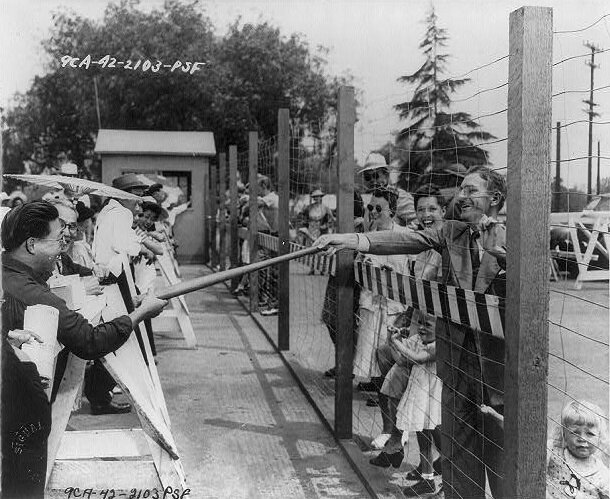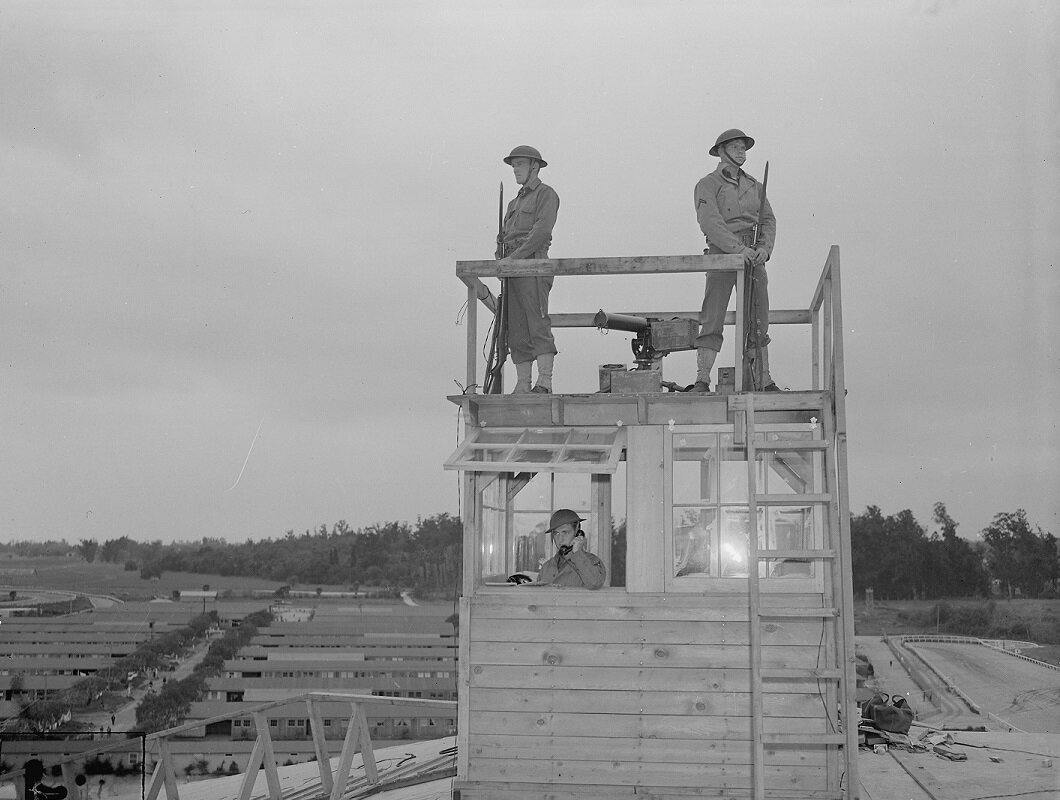Syndication News Column:
Americans Of Japanese Heritage
Part Three
Definitions
Japanese Americans are seen behind barbed wire fencing at the Pomona Assembly Center (Pomona Prison) that
was operated by the Federal government on the grounds of the Los Angeles County Fairgrounds.
(The photograph was created by Civil Affairs Division of the Office of Assistant Chief of Staff, Western
Defense Command and Fourth Army, and provided courtesy of the Library of Congress, 1942.)
When a hurricane is approaching the Gulf Coast of the United States, it is not unusual to see news reports detailing how government officials are working to evacuate people – American citizens, permanent residents from other nations, and visitors to the area – from communities that may be hit by storms. It is not unusual to also read about how government officials are relocating these citizens, permanent residents, and visitors to safer areas. Sometimes, relocation centers are established to house, feed, and otherwise serve the American citizens, permanent residents, and visitors evacuated from areas hit by disaster.
For the most part, citizens, residents, and visitors have the ability to accept or decline the offers of assistance by the government officials. These efforts are usually – not always, but usually – applauded by citizens, residents, and visitors alike so that human life is protected.
“Evacuation” and “relocation” are words in the English language that accurately describe these activities.
Those two words, though, do not adequately describe the activities of government officials in early 1942.
The caption for this photograph included the wording “Caucasian handing evacuee a baseball bat through
wire fence…” at the Santa Anita Assembly Center (Santa Anita Prison) operated by the Federal government
on the grounds of the Santa Anita Racetrack in Arcadia (Los Angeles County), California.
(The photograph was created by the Army Signal Command and provided courtesy of the Library of Congress, 1942.)
When government officials demand that you have between 48 hours and a couple weeks, depending on your locale, to vacate your home and close your business, a strong statement is being made by the Federal government. When government officials demand that you present yourself at a racetrack, a fairground, or a similar site with only the items you can carry from your home, a strong statement is being made by the Federal government. When government officials demand that you live – temporarily – in places like a horse stable while a new prison is built to house you, a strong statement is being made by the Federal government.
“Voluntary,” “evacuation,” and “relocation” as well as “assembly center,” “relocation camp,” and “relocation center” were the words used by the Federal government – and most others – to describe the situations involving actions against people with Japanese heritage in California and sections of Arizona, Oregon, and Washington in 1942 through 1945. These same words were used to detail similar situations that were undertaken, though on a much more limited basis, against individuals with Japanese heritage in other states and for individuals with Aleut, German, Italian, and select other heritages throughout the United States.
“Taken into custody,” “imprisonment,” and “prison” are words in the English language that are more accurate to describe these situations. In addition, “internment camp” and “concentration camp” have also been used by others to more accurately detail the locales used to house people not convicted of any criminal activities.
As such, the news columns detailing how American citizens and residents of the United States were taken into custody by the Federal government utilize the more accurate wording: Individuals were imprisoned by the Federal government. American citizens and residents of the United States were housed in prisons operated by the Federal government. Those prisons ranged from horse stables at racetracks to barracks built behind barbed wire, among other facilities. Freedom of movement was explicitly denied by the Federal government.
“Evacuees are shown returning to the center for lunch after clearing the land of brush and weeds around
the boundary of this War Relocation Authority center,” was part of the caption for this photograph from
the Manzanar Relocation Center (Manzanar Prison) operated by the Federal government near
Independence, California. “Army Military Police guard these boundaries.”
(The photograph was created by Mr. Clem Albers and provided courtesy of the National Park Service, Date Uncertain.)
Beyond officials with the Federal government, elected and appointed leaders with other governmental entities – state and local – strongly supported the actions of the Federal government.
Many people in the United States supported the actions of the Federal government.
It took 34 years for a President of the United States to rescind the Presidential Proclamation 9066 that was used to imprison people of Japanese heritage.
It took 46 years for the United States Congress and a President of the United States to formally apologize to the people imprisoned because of racial bias.
The caption for this photograph: “Persons of Japanese ancestry arrive at the Santa Anita Assembly center
[Santa Anita Prison] from San Pedro, California. Evacuees lived at this center located at the former Santa
Anita race track before being moved inland to relocation centers [other prisons].
(The photograph was created by Mr. Clem Albers for the War Relocation Authority of the U S Department of the Interior
and provided courtesy of The United States National Archives and Records Administration, April 6, 1942.)
Military police with bayonets are seen here, according to The United States National Archives and Records Administration,
“…on duty in watch-tower at Santa Anita park assembly center [Santa Anita Prison] for evacuees of Japanese ancestry.”
(The photograph was created by Mr. Clem Albers for the War Relocation Authority of the U S Department of the Interior
and provided courtesy of The United States National Archives and Records Administration, April 6, 1942.)
A military police officer is seen here on a patrol along the fence around the Santa Anita Racetrack
[Santa Anita Prison] where Japanese Americans were imprisoned by the Federal government.
(The photograph was created by Mr. Clem Albers for the War Relocation Authority of the U S Department of the Interior
and provided courtesy of The United States National Archives and Records Administration, April 6, 1942.)
© 2020 Richard McDonough





